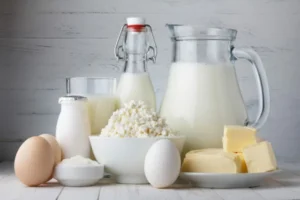
Arla Foods (the Swedish-Danish dairy cooperative) and Germany’s DMK Group announced plans to merge on April 8, 2025. This union will create Europe’s largest dairy cooperative, uniting over 12,000 farmer-owners with a combined revenue of around €19 billion.
The move aims to secure a larger milk pool and strengthen global competitiveness, though it still awaits approval from cooperative members and regulators.
Key numbers and figures combined
- Annual revenue (latest): ~€19 billion (pro forma). Arla ~€13.8 B, DMK ~€5.1 B.
- Milk intake: ~19 billion kg of milk per year (Arla ~13.7 B kg; DMK ~5.3 B kg).
- Farmer-owners: ~12,200 dairy farmers (Arla ~7,600 across 7 countries; DMK ~4,600, primarily in Germany and the Netherlands).
- Employees (FTE): ~28,700 combined (Arla ~21,900 staff; DMK ~6,800).
- Processing sites: ~80+ dairy plants globally. (Arla operates dozens of production facilities across Northern Europe and beyond, while DMK runs 20+ sites in Germany, Netherlands, and other hubs.)
- EBIT margin (3-year avg): Arla ~3.6%, DMK ~1.1% (2011–2023 average EBIT as % of sales – illustrating typical thin margins in the dairy coop model).
- Net sales growth (last 3 years): Arla ~+9% CAGR (boosted by a 23% spike in 2022, then flat in 2023); DMK ~0% (essentially flat sales 2021–2023, with only marginal changes year-to-year).
- Milk price payout (2024 avg): Arla ~€0.509 per kg to farmers; DMK ~€0.473 per kg. (Both co-ops saw improved milk prices in 2024 after a dip in 2023, but high farmgate prices also squeeze their profit margins.)
Context and background
Ownership structure
Both are farmer-owned cooperatives. Arla’s owners (~7.6k farmers) span Denmark, Sweden, the UK, Germany, Belgium, Luxembourg, and the Netherlands.
DMK’s owners (~4.6k) are largely in Germany with some in the Netherlands (after DMK’s earlier merger with Dutch co-op DOC Kaas). This merger solidifies a farmer base of over 12k, emphasising cooperative control in multiple countries.
Brands and products
Arla brings a portfolio of well-known global brands – Arla®, Lurpak (butter), Puck (Middle East dairy products), Castello (specialty cheeses), and also licenses Starbucks ready-to-drink beverages.
DMK contributes strong regional and B2B brands like MILRAM (a leading German dairy brand), Oldenburger (export brand, popular in markets like China), Uniekaas (Dutch cheese), Humana and Alete (infant nutrition). Product categories cover everything from liquid milk, cheese and butter to baby food, ice cream, whey ingredients and even plant-based alternatives.
This complementary mix could broaden the combined entity’s market reach.
Global footprint
Arla is a top-tier global dairy player, with strong presence across Europe, the Middle East, North America, and Asia. It is the world’s largest producer of organic dairy and a major exporter to growth markets.
DMK, while more focused on Germany/Europe, is among the largest suppliers to the German retail sector and has established export markets (e.g. DMK’s Oldenburger brand is growing in China).
The merged co-op will have an even more diversified geographic footprint and product mix, enhancing global market access.
Prior Arla–DMK collaborations
Notably, Arla and DMK have a history of collaboration that paved the way for this merger. They co-own ArNoCo, a 50/50 joint venture since 2011 that processes DMK’s cheese whey into whey protein concentrate and lactose for Arla’s ingredients business. They also struck a mozzarella production partnership in 2017, where DMK’s Nordhackstedt plant produces 35,000 tons of mozzarella per year for Arla’s global markets.
These successful joint projects have built trust and demonstrated synergies – essentially a trial-run for working together, now culminating in a full merger.
Strategic insights and potential impact
Bold move by Arla
This merger is a decisive strategic leap by Arla, seizing scale while some peers remain cautious. Rival cooperatives like Royal FrieslandCampina (Netherlands) have recently pursued a comparable consolidation with Milcobel (Belgium). Although both consolidations aim to secure scale and milk supply security, the benefits and scale of integration may differ.
Arla’s proactive approach in acquiring DMK (Germany’s #1 coop) contrasts with competitors that have been slower to act. It sends a clear message: Arla intends to shape the industry’s future, rather than merely react to it.
Scale and supply security
The strategic logic of the deal aligns with classic dairy strategy: scale up to drive efficiency and secure milk supply. By combining, Arla-DMK ensures a stable milk pool of ~19 billion kg in a time of declining milk production in Europe.
Greater scale can spread overhead costs, improve processing optimisation, and strengthen bargaining power with retailers and suppliers. In an industry where volume matters, this new giant can invest in innovation and global market development with more confidence.
The merger also helps ensure neither co-op is left scrambling for milk if the European milk pool shrinks further – it’s about cornering a large share of sustainable milk volumes for the long term.
Size is not equal to guaranteed profit
A bigger milk pool and revenue base are good, but this merger alone won’t fix the fundamental profitability challenge. Both Arla and DMK have operated on very thin margins. Arla’s EBIT margin hovered around 3–4% in recent years, and DMK’s around 1% (with DMK’s 2023 net profit only €13 million on €5.5 billion revenue).
These razor-thin margins are largely due to the high cost of European milk (farm-gate milk prices ~40–50 €cents/kg) and a product mix still weighted towards commodities or low value-add products. Simply merging doesn’t suddenly make European milk cheaper or commodity cheese more profitable.
Without a shift toward higher value products or efficiency breakthroughs, the combined co-op may still struggle to significantly lift its margin. In short, scale helps, but strategy (moving up the value chain, innovation, branding) will determine if they can escape the European dairy ‘red ocean’ of slim profits.
Integration risks – don’t take eyes off the market
Merging two large cooperatives is an enormous managerial task. Over the next 1–2 years, Arla-DMK will be internally focused on integration: aligning farmer payment systems, consolidating plants, streamlining product portfolios, and merging corporate cultures.
This brings a risk of inward focus just as external market pressures continue. Competitors (from big multinationals to nimble niche players) will not stand still. There’s a danger that while Arla-DMK looks inward, rivals could capitalise on market opportunities or poach disaffected farmers. The new mega-coop must ensure it doesn’t become so absorbed in internal restructuring that it misses shifts in consumer demand, new export openings, or threats like plant-based alternatives advancing.
Successful integrations in dairy (or any industry) require multitasking: achieving internal unity and staying externally alert.
The value-add imperative
The merger underscores an evolving industry truth – volume alone isn’t enough. To really succeed, the combined Arla-DMK needs to leverage its scale to move beyond basic commodities.
That means investing in value-added products (think advanced ingredients, specialised dairy nutrition, strong brands with pricing power) and innovation in sustainable dairy (to justify that European milk premium). Both co-ops have such initiatives (Arla has Arla Foods Ingredients and strong brands; DMK has niche units like baby food and pharma lactose), but the urgency will grow to make a larger portion of their portfolio high margin.
Industry executives will be watching how the new entity drives innovation and value creation to complement its scale.
Outlook – opportunity with caveats
Strategically, the Arla-DMK merger has a clear rationale: it creates a European dairy powerhouse with the scale to compete in a global market and weather supply/demand volatility. It’s a proactive step when many dairy co-ops are struggling with stagnation.
However, the true test will be execution – turning scale into sustainable profitability and growth. If they can streamline operations, avoid internal conflicts (common in coop mergers), and push into higher-margin business, this new giant could set the template for dairy consolidation. If not, it may simply be a larger ship facing the same storms.




